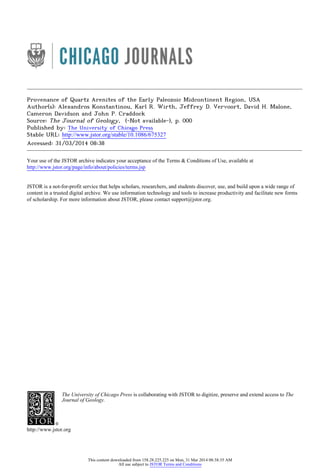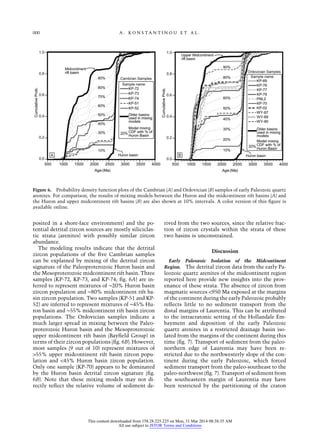This document discusses the provenance of quartz arenite sandstones from the early Paleozoic midcontinent region of the USA. The authors present new detrital zircon geochronology data from 15 Cambrian and Ordovician quartz arenite samples. They compare this to existing data from older sedimentary basins in the region, including the Huron basin and midcontinent rift deposits. Mixing models using the older basin zircon populations indicate the early Paleozoic sandstones represent mixtures derived primarily from erosion of these two source areas.

![Provenance of Quartz Arenites of the Early Paleozoic
Midcontinent Region, USA
Alexandros Konstantinou,1,* Karl R. Wirth,2 Jeffrey D. Vervoort,3 David H. Malone,4
Cameron Davidson,5 and John P. Craddock2
1. Department of Geological and Environmental Sciences, Stanford University, Stanford, California 94305, USA;
2. Geology Department, Macalester College, St. Paul, Minnesota 55105, USA; 3. Department of Geology,
Washington State University, Pullman, Washington 99164, USA; 4. Department of Geography-Geology,
Illinois State University, Campus Box 4400, Normal, Illinois 61790, USA; 5. Geology Department,
Carleton College, Northfield, Minnesota 55057, USA
ABSTRACT
Quartz arenites characterize much of the early Paleozoic sedimentary history of the midcontinent region. Despite
numerous studies, the century-long debate on how these arenites formed is still unresolved, primarily because of the
compositional and textural purity of the deposits. In this study, we present an extensive data set of detrital zircon
geochronology from the early Paleozoic supermature arenites of the midcontinent region, and we offer newconstraints
about their origin. Our results coupled with compiled provenance information from older basins and orogens may
indicate that the Cambrian and Ordovician arenites represent sediment reworking primarily of two different older
basins. The Cambro-Ordovician sediment was transported to the midcontinent region by two early Paleozoic river
systems that sourced from the paleo-east (Huron basin) and paleo-northeast (midcontinent rift region).
Online enhancement: supplementary table.
[The Journal of Geology, 2014, volume 122, p. 000–000] 2014 by The University of Chicago.
All rights reserved. 0022-1376/2014/12202-0005$15.00. DOI: 10.1086/675327
1
Introduction
The provenance of quartz arenites has puzzled ge-ologists
for more than a century, largely because
the textural maturity and compositional purity of
such deposits leave few clues about the source of
detritus (e.g., Sardeson 1896; Dott et al. 1986; Dott
2003). The early Paleozoic (Cambrian-Ordovician)
quartz arenites of the midcontinent region (fig. 1),
such as the Cambrian Jordan and Ordovician St.
Peter Sandstones (Runkel et al. 2007), are excep-tional
examples of thin sheets of widespread are-nites
deposited in low-relief cratonal settings over
periods of tens of millions of years. Chemical
weathering has been proposed to play an important
role in the development of the compositional and
textural maturity of these rocks (Runkel et al. 1998,
2012; Driese et al. 2007). Evidence to support this
idea comes from interbedded finer-grained feld-
Manuscript received August 25, 2013; accepted December
10, 2013; electronically published March 19, 2014.
* Author for correspondence; e-mail: akonstan@alumni
.stanford.edu.
spathic sandstone layers that are rich in potassium
feldspar but contain only trace amount of plagio-clase
feldspar (Odom 1975; Odom and Ostrom
1978). Because potassium feldspar is more chemi-cally
resistant than plagioclase feldspar, and be-cause
both minerals have similar resistance to
physical weathering, Runkel and Tipping (1998)
suggested that chemical weathering in the cratonal
interior, which now exposes large areas of saprolite,
may have resulted in a source area dominated min-eralogically
by quartz grains.
Although chemical weathering appears to pro-vide
a viable mechanism to explain the composi-tional
purity of the early Paleozoic quartz arenites,
the mechanism producing the textural maturity of
these deposits is less certain, since chemicalweath-ering
has been inferred to play a minor role in de-veloping
the roundness and sphericity of the quartz
grains and the well-sorted nature of the strata (e.g.,
Runkel et al. 2012 and references therein), thus re-quiring
an alternative explanation for the round-
This content downloaded from 158.28.225.225 on Mon, 31 Mar 2014 08:38:35 AM
All use subject to JSTOR Terms and Conditions](https://image.slidesharecdn.com/a321e6ac-07ac-4f01-9a81-8c489d82c57f-141203204445-conversion-gate02/85/konstantinou-et-al-2014-2-320.jpg)

![Journal of Geology P R O V E N A N C E O F QUART Z A RE NI T E S 000
longed history of erosion in the swash zones of mar-ginal
marine (beach) environments. Transportation
and abrasion of the quartz grains also may have
been achieved by wind, which is a more effective
process to enhance rounding, as evidenced by eo-lian
deposits within some of the early Paleozoic
arenites (Dott et al. 1986). In fact, eolian transport
and wind abrasion has been proposed to be more
effective in producing the textural maturity of the
sandstone deposits, especially in the unvegetated
landscape of the early Paleozoic (Dott et al. 1986,
2003).
In addition to special conditions of weathering,
transportation, and abrasion conditions proposed to
explain the textural maturity of the early Paleozoic
quartz arenites in the midcontinent region, other
workers have proposed that the textural (and com-positional)
maturity can be achieved more effec-tively
by recycling older, already texturally mature
strata (e.g., Amaral and Pryor 1977; Runkel 1994;
Johnson and Winter 1999). Nevertheless, while
each of the processes described above may have
been important in the formation of the early Pa-leozoic
quartz arenites, there is still no consensus
that can fully account for the textural maturity and
compositional purity of these rocks (see Runkel et
al. 2012 and references therein).
The purpose of this study is to better understand
the origin of compositionally and texturallymature
early Paleozoic quartz arenites of themidcontinent
region, by adding geochronologic data to the exist-ing
heavy mineral studies in the region (e.g., Tyler
et al. 1940). To address this question we dated de-trital
zircon populations (np1578; U-Pb with laser
ablation [LA] ICP-MS) of 15 samples from Cam-brian
and Ordovician quartz arenites. We coupled
our results with an extensive detrital zircon geo-chronologic
database (n p 2729) from older sedi-mentary
deposits such as the Archean Huron Basin
(2400–2200 Ma), the Proterozoic Animikie Group
(2200–1800 Ma), the deposits in the Paleoprotero-zoic
Baraboo Interval (∼1730–1630 Ma), and the
Mesoproterozoic midcontinent rift deposits (1110–
1030 Ma). Based on the detrital zircon populations
of the early Paleozoic quartz arenites and the older
source basins, we have identified two possible
source regions that most probably were eroded and
recycled during early Paleozoic sedimentation. We
performed simplified mixing models between the
Huron Basin and midcontinent rift detrital zircon
populations, and we are able to demonstrate that
the detrital zircon populations of the early Paleo-zoic
quartz arenites may represent mixtures be-tween
these two older sources.
Regional Geology and Stratigraphy
Early Paleozoic marine and fluvial strata exposed
in the midcontinent region are composed mostly
of interbedded feldspathic sandstone, thin sheets of
quartz sandstone, and lesser mudstone and carbon-ate
rocks (fig. 2). These strata rest unconformably
on Archean (Superior Province) and Proterozoic
basement rocks (Penokean, Yavapai, and Mazatzal
orogens and midcontinent rift; fig. 1; Dott et al.
1986; Van Schmus et al. 1996). The early Paleozoic
strata were deposited during a northward sea trans-gression
that flooded the broad lowland of the Hol-landale
Embayment, which is bounded by the Wis-consin
dome to the northeast and the Wisconsin
arch to the east (fig. 1; Galarowich 1997). The sed-iment
was deposited on a nearly flat, unvegetated
cratonic landscape that was weathered and eroded
for hundreds of millions of years (e.g., Dott 2003).
Wind and rivers transported sediment toward the
southwest (fig. 1) and distributed clastic sediments
in thin, flat widespread sheets, covering large areas
from Minnesota (northwest) to Missouri (south-east).
Late Cambrian strata like the Eau Claire For-mation,
Mount Simon, Wonewoc, Tunnel City
Group, and Jordan Sandstones are predominantly
composed of feldspathic and quartz arenites with
minor thinly bedded dolostone (fig. 2). These strata
were deposited during the Sauk transgressive cycle
on a shallow marine shelf sloping south and south-east,
and their ages are well constrained by fossils
(e.g., Feniak 1948; Berg 1952; Nelson 1956; Sloss
1963; Mossler 1987; Byers and Dott 1995). Lower
and Middle Ordovician strata are composed of do-lostones
(e.g., Oneota Dolomite and Shakopee For-mation)
and quartz arenites such as the St. Peter
Sandstone. Large extents of Ordovician strata were
deposited during sea level rise of the Tippecanoe
transgression (base of Middle Ordovician; Sloss
1963; Meyers and Peters 2011). Regional evidence
such as facies relationships and paleoshoreline
trends support placing the source and direction of
sediment transport in the northeast relative to the
present-day arrangement of the midcontinent re-gion
(e.g., Dott et al. 1986; Runkel 1992, 1994; Run-kel
et al. 2007).
Detrital zircon geochronology was performed on
15 samples collected over a large geographic area
(1400 # 500 km; fig. 1; table S1, available online)
and from eight different units of the composite
early Paleozoic stratigraphy (fig. 2). Our samples
were collected from units inferred to have been de-posited
on fairly discrete, well-developed shoreface
This content downloaded from 158.28.225.225 on Mon, 31 Mar 2014 08:38:35 AM
All use subject to JSTOR Terms and Conditions](https://image.slidesharecdn.com/a321e6ac-07ac-4f01-9a81-8c489d82c57f-141203204445-conversion-gate02/85/konstantinou-et-al-2014-4-320.jpg)












